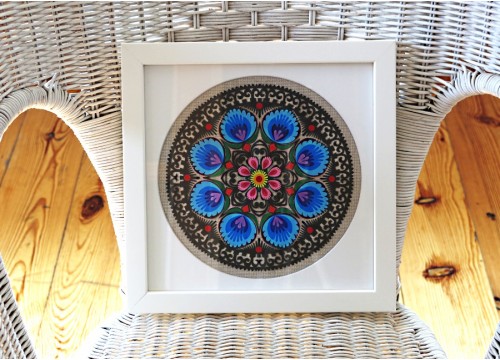
| You have no items in your shopping cart |
Transportation cost: Poland: 14 - 16 zł, Worldwide: from 22 zł

| You have no items in your shopping cart |
A hand-made by a master of Polish handicraft and beautifully framed traditional Łowicz paper cut-outis the Pearl of the Central Region. A special attention is drawn to extraordinary play of shapes and colours – its rich ornamentation is characteristic of Łowicz paper cut-outwhich is created by gluing consecutive elements of the pattern on top of one another.
The presented paper cut-out is a typical example of a classical Łowicz star – one of the two most popular paper cutouts in Łowicz Region. It is a symmetrical composition filled with vegetable motifs. There is a daisy in the centre which is surrounded by circles with multi-coloured wreaths that are interwoven with discreet black elements.
Check out how interestingly this paper cut - out can decorate todays' interior!
Special attention should be drawn to a very elaborate and artistic paper cut-out frame which was individually chosen by a professional framing studio. The frame is made from white, mat wood. A blue passe partout perfectly accentuates the cheerful composition and a double window, the cut out is placed, gives the three-dimensional effect. The round-shaped paper cut-outis fitted in a square frame, which additionally creates an interesting play of shapes. A pane protects the paper cut-outagainst destruction. The frame is provided with a support enabling it to be hung or stood in an easy way.
A cutout is a colourful picture made of paper, created by intricate cutting. It is one of the most characteristic elements of Polish folk art. Nowhere, apart from Poland, the variety of paper cutouts is so large. Paper cutouts developed in mid-19th century, mainly in central and eastern Poland, and were one of the most important forms of house decoration.
It is possible that cutouts were inspired by stars sticked to windows in Jewish houses. Cutouts were made by women: they used paper bought from travelling salesmen. They were inspired by nature and their imagination. It is interesting that cutouts are made on the spot, without drawing a model first. Initially, they were cut with sheep scissors, held by blades to use the energy of flexible steel.
Cutout style developed in Central Poland was slightly different from the style in the eastern part of the country. Here it is not only shape that is important, but also the colour. Lowicz cutout is a composition of 5, 7, or even 10 colours. "Gwiozda" and "Kodra" are the most important types. They are made by gluing consecutive layers of elements. "Gwiozda" is a symmetrical composition, filled with floral motives: trees mainly, sometimes also birds. "Kodra" is a rectangular cutout, often showing scenes from everyday life. In the past "Kodra" was attached to ceiling beams as a decoration. Today also it may beautifully decorate your house.
 Mrs Helena had started her cutout handicraft in the age of 14. Her master was Mr Zdzislaw Pągowski - a demanding teacher, who used to advise her how an authentic Lowicz cutout should look like. He encouraged to develop her own style and to stick to it.
Mrs Helena had started her cutout handicraft in the age of 14. Her master was Mr Zdzislaw Pągowski - a demanding teacher, who used to advise her how an authentic Lowicz cutout should look like. He encouraged to develop her own style and to stick to it.
Mrs Helena’s works are famous not only in Poland, but also abroad: in the USA, Netherlands, Belgium, in Italy or France.
 What makes our cutouts special? It is not only originality and masterwork of this handicraft, but also individually selected to each cutout frame and background by a professional framing studio. An appropriate composition of a frame and a background strengthens beauty of this handicraft and gives an unparalleled effect. This is how a cutout becomes a picture fitting to the most demanding interiors.
What makes our cutouts special? It is not only originality and masterwork of this handicraft, but also individually selected to each cutout frame and background by a professional framing studio. An appropriate composition of a frame and a background strengthens beauty of this handicraft and gives an unparalleled effect. This is how a cutout becomes a picture fitting to the most demanding interiors.
No customer reviews for the moment.
















